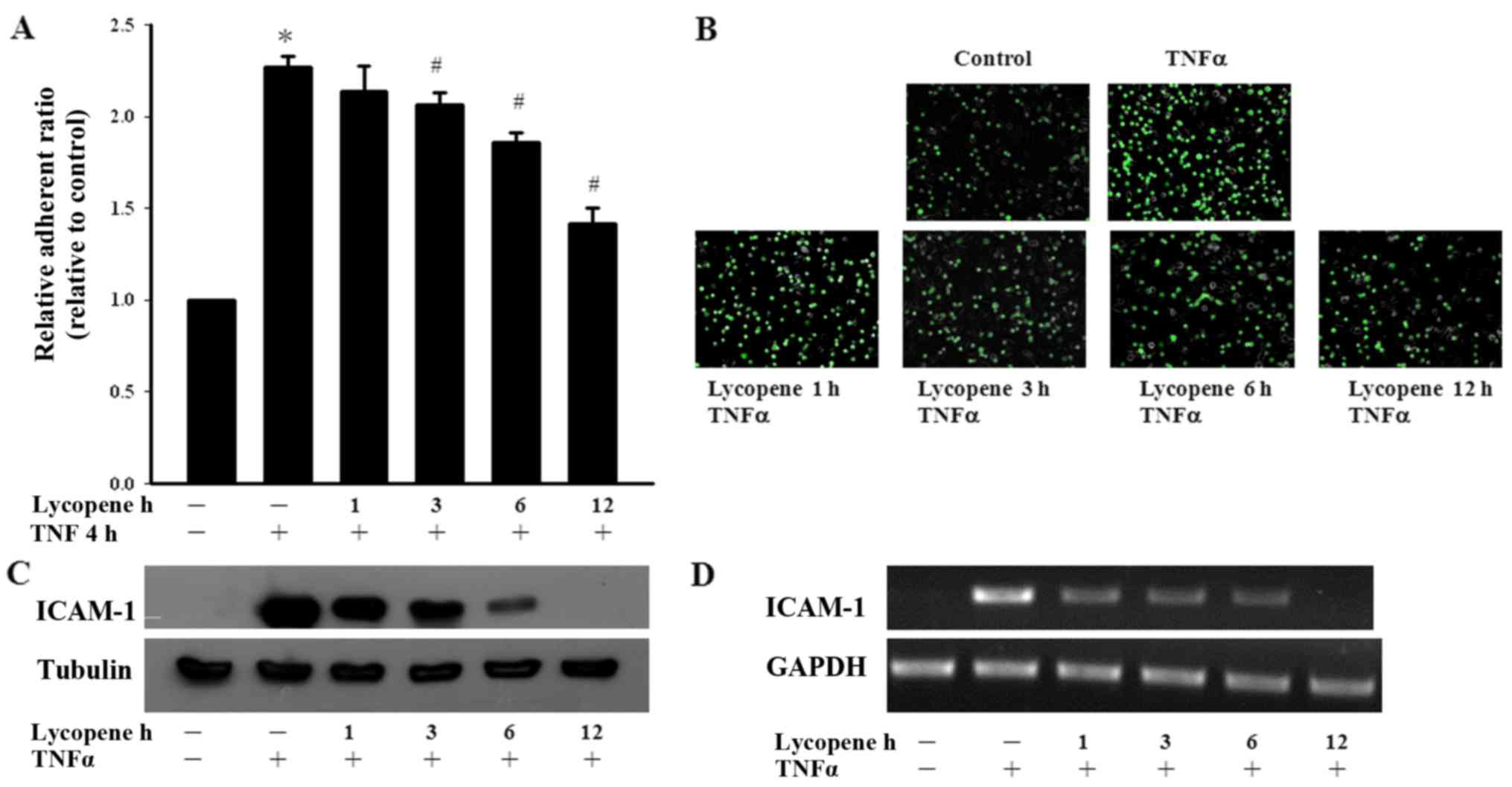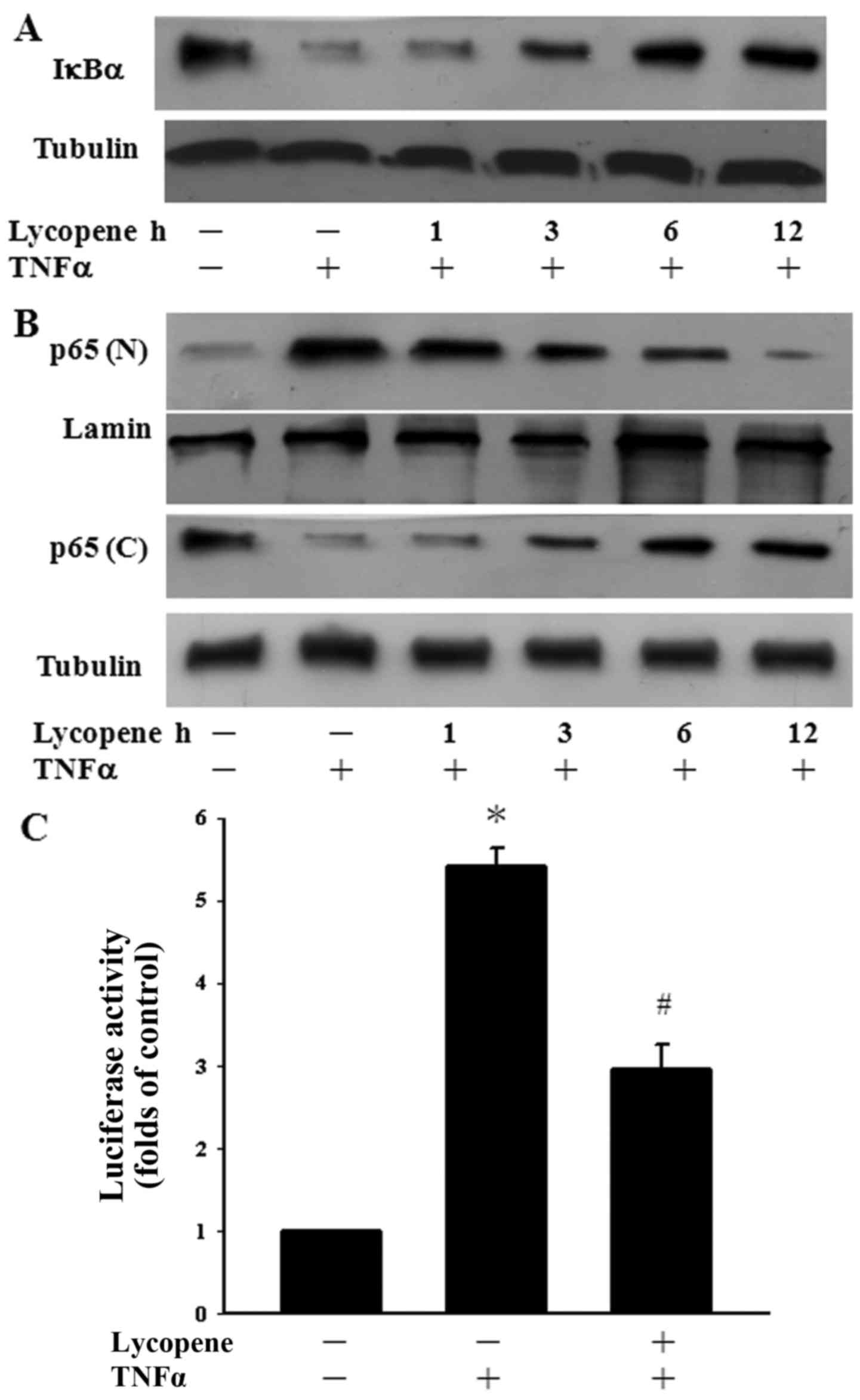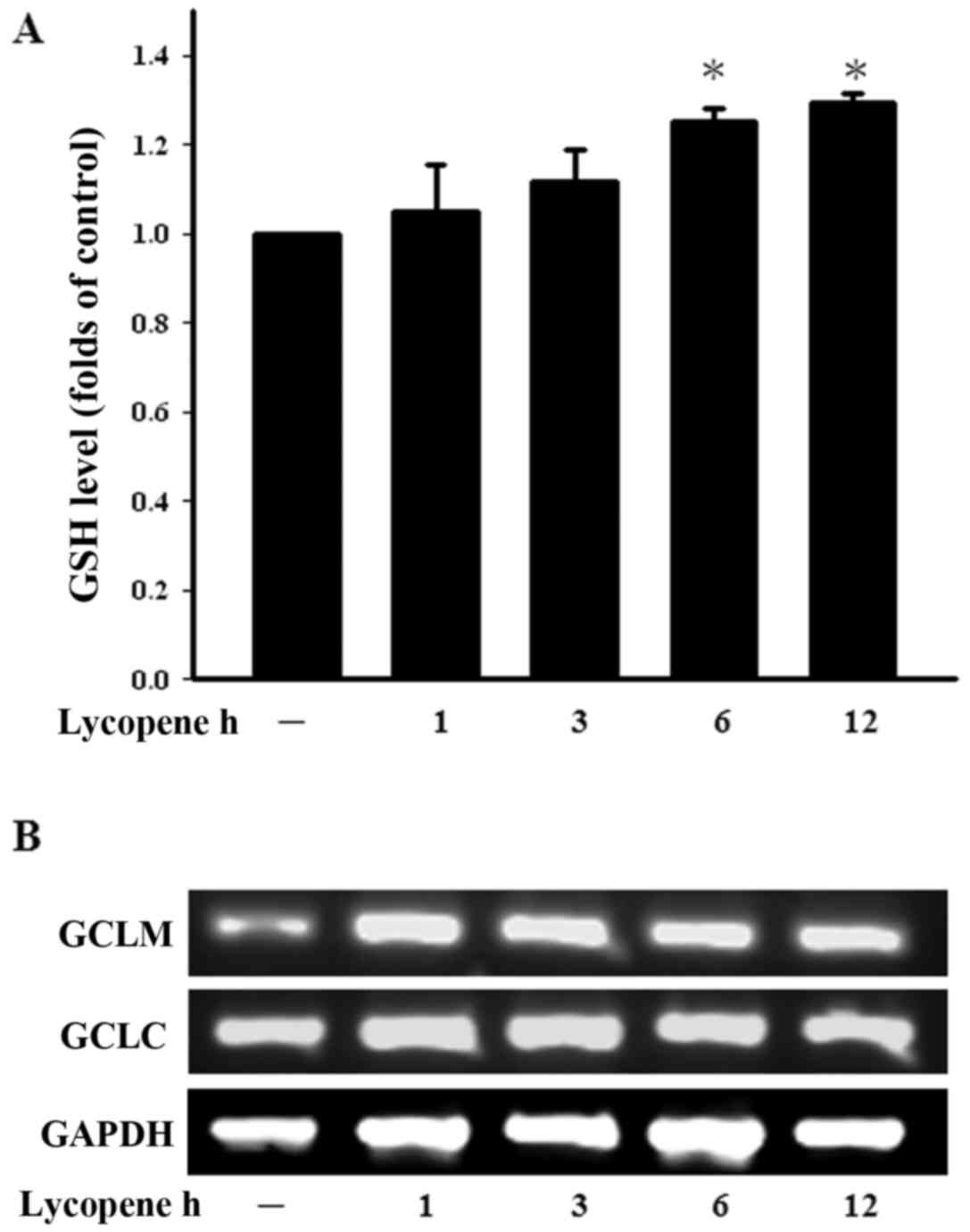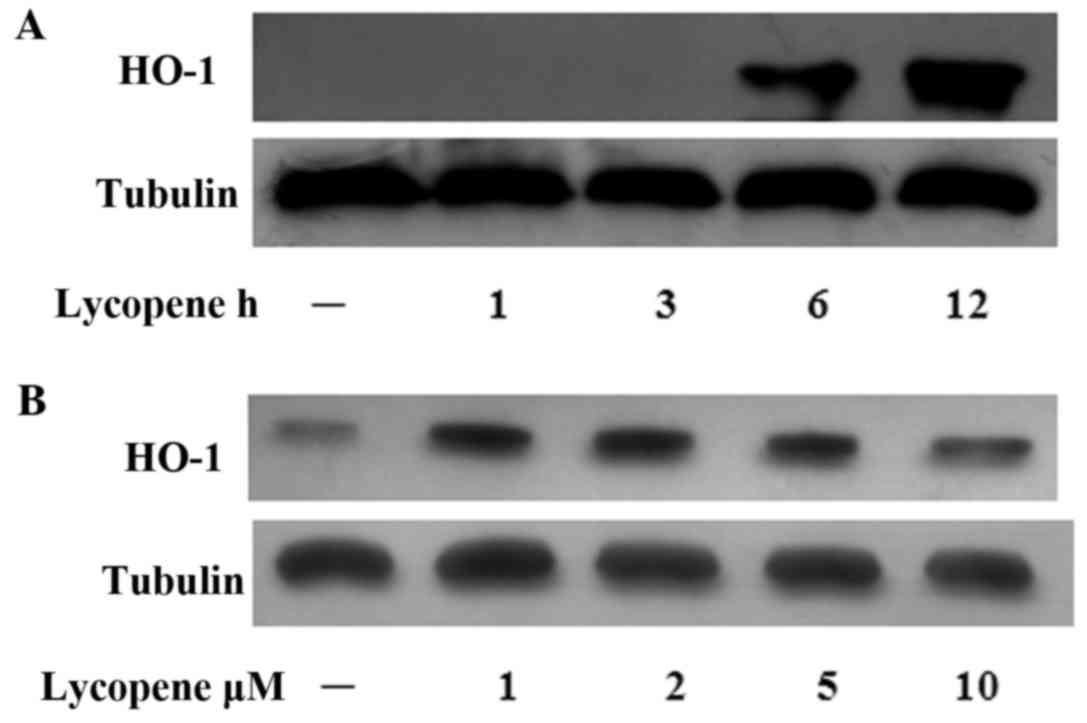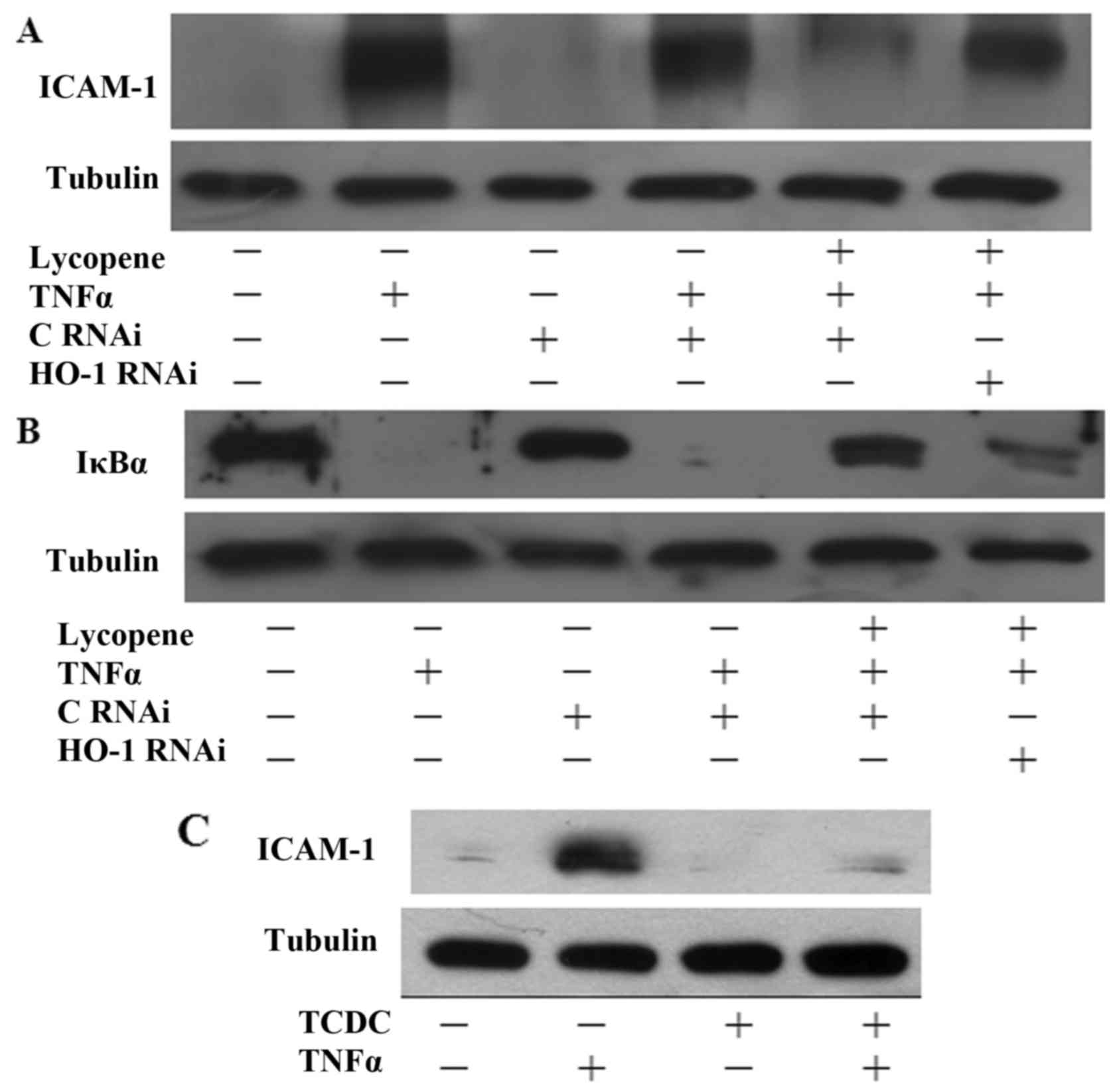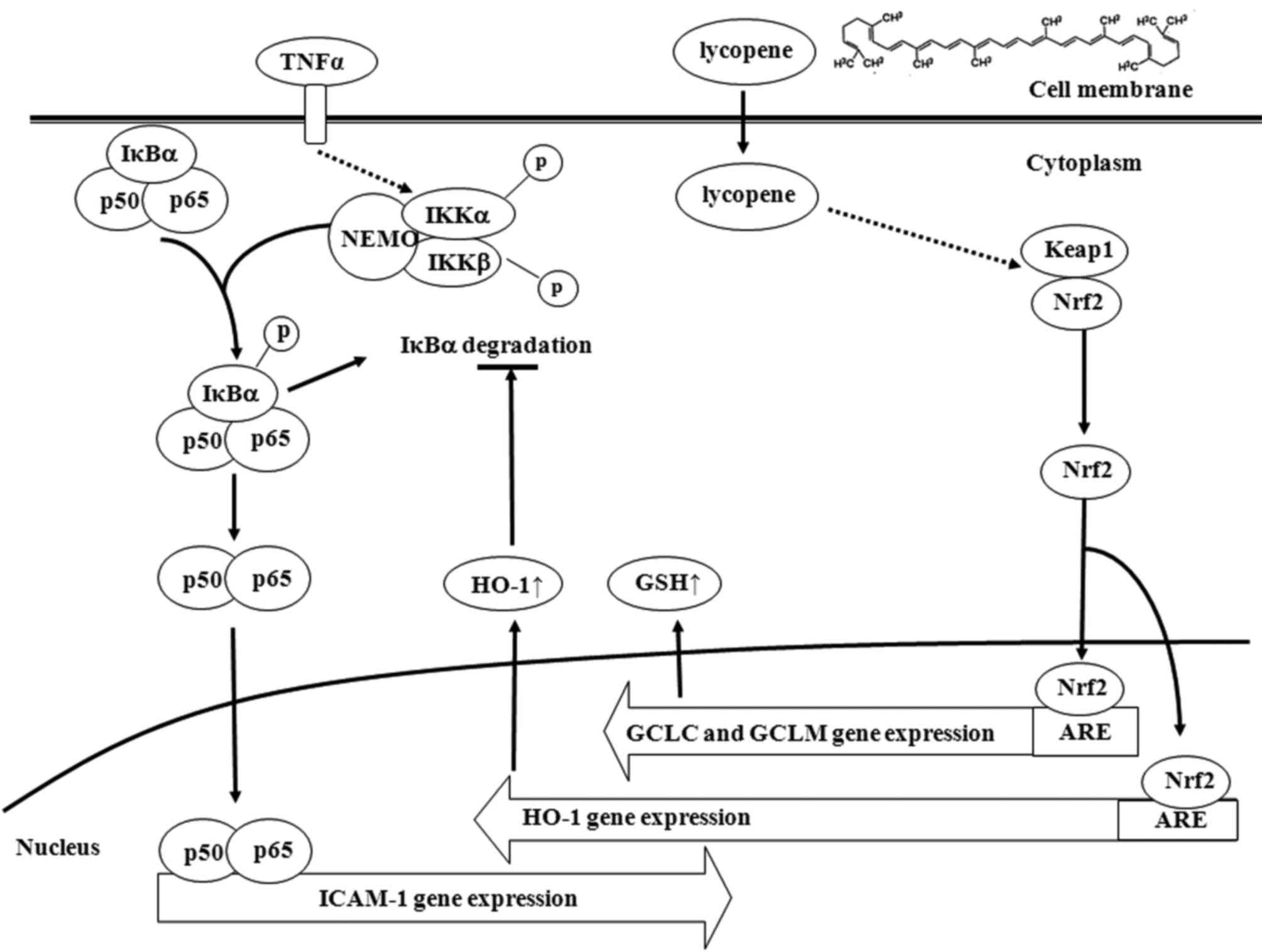Lycopene inhibits NF-κB activation and adhesion molecule expression through Nrf2-mediated heme oxygenase-1 in endothelial cells
- Authors:
- Published online on: April 20, 2017 https://doi.org/10.3892/ijmm.2017.2960
- Pages: 1533-1540
Abstract
Introduction
Atherosclerosis is a chronic inflammatory disease which develops in response to injury in the vessel wall (1,2). A number of chronic diseases are known to be involved in the pathogenesis of inflammation, including atherosclerosis, Alzheimer's disease and Parkinson's disease (3). Endothelial cells (ECs) recruit circulating monocytes via a multi-step process mediated by a combination of cell surface adhesion molecules, such as intercellular cell adhesion molecule-1 (ICAM-1) during inflammation (2). Pro-inflammatory cytokines, such as tumor necrosis factor α (TNFα) commonly found in inflammation, can activate nuclear factor-κB (NF-κB) which plays a key role in the expression of cell adhesion molecules (1,4). Following stimulation with TNFα, a kinase cascade is activated that induces subsequent IκB phosphorylation. Phosphorylated IκB is rapidly degraded, resulting in the release of NF-κB, which enters the nucleus and regulates gene transcription (5).
Lycopene is a natural carotenoid that is present in tomatoes and tomato-based products. Other dietary sources of lycopene also include pink grapefruit, papaya, watermelon and dried apricotscarotenoid (6). It has been reported that the dietary intake of tomatoes containing lycopene reduces the risk of chronic diseases and various types of cancer (7). Previous epidemiologic studies have found that the dietary intake of lycopene was significantly associated with plasma lycopene concentrations (8). The mean plasma level of lycopene has been found to be 0.59 µM, ranging from 0.07 to 1.79 µM and it contributes to approximately 21–43% of the total carotenoids (8,9). Lycopene exerts several biological functions, such as acting as an antioxidant and reducing low density lipoprotein cholesterol levels (10); it also reduces pro-inflammatory cytokine and chemokine expression in macrophages (11,12). Indeed, lycopene has been found to decrease the expression of several genes by modulating the NF-κB signaling pathway in ECs (13). These results provide a possible mechanism for the anti-inflammatory effects of lycopene related to its antioxidant activity. However, the detailed mechanisms responsible for the anti-inflammatory effects of lycopene remain to be elucidated.
The transcription factor, nuclear factor-erythroid 2 related factor 2 (Nrf2), which binds to the antioxidant response element (ARE), is essential for the induction of phase II detoxification and antioxidant enzymes (14–16). A previous study further demonstrated that the activation of Nrf2 abolishes inflammatory gene expression in ECs (17). Heme oxygenase (HO) is a cytoprotective and a rate-limiting enzyme, and it degrades heme to bilirubin, carbon monoxide (CO) and iron (18). HO-1 is an Nrf2-mediated phase II enzyme upregulated in conditions of oxidative stress, cellular injury and disease (18). In our previous study, we reported that the Nrf2-induced expression of HO-1 and the related signaling pathways exerted anti-inflammatory effects in ECs (19). Recently, we also demonstrated that HO-1 exerts anti-inflammatory effects by its derivative CO production (20,21). However, the detailed mechanisms responsible for the anti-inflammatory effects of lycopene in ECs have not yet been fully elucidated. Thus, in the present study, we investigated the molecular mechanisms underlying the anti-inflammatory properties of lycopene in ECs. We aimed to investigate whether HO-1 expression contributes to lycopene-regulated anti-inflammatory responses. We found that the lycopene-induced accumulation of Nrf2 in the nuclei was closely associated with the upregulation of HO-1, which led to anti-inflammatory effects in ECs.
Materials and methods
The p3xARE/Luc and NF-κB/Luc vectors were constructed by introducing the Nrf2 binding site or NF-κB binding site into the pGL3 promoter plasmid (Promega, Madison, WI, USA), respectively as described in a previous study (22). Luciferase assay kits were purchased from Promega. Antibodies against HO-1 (SPA-896) and p65 (KAS-TF110) were purchased from Stressgen Biotechnologies (SB, San Diego, CA, USA). ICAM-1 (sc-7891), IκBα (sc-847), lamin B1 (sc-56143), α-tubulin (sc-53646) and Nrf2 (sc-722) antibodies were obtained from Santa Cruz Biotechnology (Santa Cruz, CA, USA). Bacterially-derived TNFα was purchased from Calbiochem (San Diego, CA, USA). All other reagents, including lycopene and tricarbonyl dichlororuthenium (II) dimer (TCDC) were purchased from Sigma (St. Louis, MO, USA). The CO donor, TCDC, was activated by adding the compound to culture medium to liberate CO (20).
Culture of ECs
The human umbilical vein cell line, EA.hy926 (ATCC CRL-2922) was cultured in Dulbecco's modified Eagle's medium (DMEM; Gibco-BRL, Gaithersburg, MD, USA) supplemented with 10% fetal bovine serum at 37°C under 5% CO2 in air. When the ECs were grown to confluence, the culture medium was then replaced with serum-free DMEM and the cells were incubated for 12 h prior to the experimental treatments.
Cell adhesion assay
Adhesion assay for monocytes and ECs was performed as previously described (23). Briefly, ECs grown to confluency in a 96-well plate were pre-treated with lycopene for 1–12 h and/or 100 U/ml TNFα for 4 h to allow for the expression of ICAM-1. The cells were washed with control DMEM without supplements and were co-cultured with 5×105 cells of calcein-labeled THP-1 cells (ATCC® TIB202™) in the control medium for 30 min. After washing twice with RPMI medium, the adherent cells were examined using a Fluoroscan enzyme-linked immunosorbent assay (ELISA) plate reader (FLx800; Bio-Tek Instruments, Inc., Winooski, VT, USA) at 485 nm excitation and 538 nm emission wavelengths. Fluorescence-labeled adherent cells were photographed using an Axiovert S100 microscope (Zeiss, Jena, Germany).
Western blot analysis
The cells (106) were lysed on ice in lysis buffer (1% NP-40, 0.5% sodium deoxycholate, 0.1% SDS and a protease inhibitor mixture) and whole-cell extracts were boiled for 5 min prior to separation on 10% sodium dodecyl sulfate-polyacrylamide gel electrophoresis (SDS-PAGE). The proteins were then transferred onto nitrocellulose membranes (Millipore, Bedford, MA, USA) in Tris-glycine buffer at 10 volts for 1.5 h. The membranes were then blocked with PBS containing 5% non-fat milk and incubated with primary antibodies for 2 h at 4°C with gentle shaking. After washing with PBS, the membranes were incubated with the secondary antibodies, horseradish peroxidase-conjugated goat anti-rabbit (34083) or anti-mouse (34081) antibody (Thermo Fisher Scientific, Waltham, MA, USA). The antibodies against α-tubulin and lamin were used as internal controls of the total or nuclear protein lysates, respectively. The results were visualized by chemiluminescence using ECL in according with the manufacturer's instructions.
RNA isolation and RT-PCR
Total RNA was isolated using TRIzol reagent and was reverse transcribed using SuperScript II reverse transcriptase (both from Invitrogen, Carlsbad, CA, USA) using an oligo(dT) primer according to the manufacturer's instructions. cDNA was subjected to PCR amplification using the following forward and reverse primer sets: ICAM-1, 5′-AGCAATGTGCAAGAAGATAGCCAA-3′ and 5′-GGT CCCCTGCGTGTTCCACC-3′; glyceraldehyde 3-phosphate dehydrogenase (GAPDH), 5′-TATCGTGGAAGGACTCA TGACC-3′ and 5′-TACATGGCAACTGTGAGGGG-3′; glutamate-cysteine ligase modifier subunit (GCLM), 5′-CAG CGA GGA GCT TCA TGA TTG-3′ and 5′-TGA TCA CAG AAT CCA GCT GTG C-3′; glutamate-cysteine ligase catalytic subunit (GCLC), 5′-GTT CTT GAA ACT CTG CAA GAG AAG-3′ and 5′-ATG GAG ATG GTG TAT TCT TGT CC-3′ (24). PCR products were separated on 1.5% agarose gels and visualized by ethidium bromide staining.
Preparation of subcellular fractionation for immunoblotting
The ECs were collected by scraping and lysed with cell lysis buffer (10 mM HEPES, 1.5 mM MgCl2, 10 mM KCl, 0.5 mM DTT, 0.5 mM PMSF and 0.3% nonidet P-40). The cell lysate was separated into cytoplasmic nuclear fractions by centrifugation at 500 × g for 5 min at 4°C, and the supernatant was collected and designated as the cytosolic fraction. The nuclei were washed with nuclei washing buffer and the nuclear protein was extracted using a buffer containing 25% glycerol, 20 mM HEPES, 0.6 M KCl, 1.5 mM MgCl2 and 0.2 mM EDTA for 15 min at 4°C.
Luciferase reporter assays
The ECs were transfected with NF-κB/Luc or p3xARE/Luc using Lipofectamine 2000 (Invitrogen), as previously described (22). For the luciferase assays, the cells were lysed and luciferase activity was determined by use luciferase substrate solution (Promega) and the resulting luciferase activity was measured using a luminometer. For each experiment, luciferase activity was determined in triplicate and normalized to β-galactosidase activity.
Cytotoxicity
To examine cytotoxicity, the resazurin reduction test, which is an index of the metabolic activity of living cells, was carried out using the Alamar blue® assay kit according to the instructions provided by the manufacturer (Serotec, Oxford, UK). The ECs were plated into 96-well microtiter plates (Falcon, Pittsburgh, PA, USA) at 20,000 cells/well and incubated in Alamar blue® reagent for 2 h at 37°C. Fluorescence was then measured using a Fluorescence Reader (FLx800, Bio-Tek, Winooski, VT, USA) at excitation/emission wavelengths of 570/600 nm.
Determination of GSH levels
The GSH levels were determined using the method originally described by Kamencic et al (25). Briefly, the cells cultured in 6-well plates were first washed with PBS, and 40 µM of the fluorescent probe, monochlorobimane (MCB), with PBS was added followed by incubation for 20 min at 37°C, and then washed again with PBS. Fluorescence was monitored at excitation and emission wavelengths of 405 and 510 nm, respectively, using a spectrofluorophotometer (Shimadzu, Rf-5301PC; Shimadzu, Kyoto, Japan).
RNA interference using siRNA against HO-1
The siRNA nucleotide sequence for human HO-1 was as follows: 5′-CUGUGUCCCUCUCUCUGGA-3′ and was obtained from Sigma (NM_002133). A non-targeting siRNA, 5-GCAAGCUGACCCUGAAGUUCAU-3, was purchased from Ambion (Austin, TX, USA). The EA.hy926 cells were transfected with siRNA against HO-1 (HO-1 siRNA) or non-targeting siRNA using Lipofectamine 2000 reagent according to the manufacturer's instructions. After 24 h of transfection, the ECs were then cultured in medium without serum for another 12 h prior to the treatments.
Statistical analysis
The values are expressed as the means ± standard error of the mean (SEM) of at least 3 independent experiments. Statistical significance was assessed by one-way analysis of variance (ANOVA) followed by Tukey's test. A confidence limit of P<0.05 was considered to indicate a statistically significant difference.
Results
Lycopene inhibits both monocyte adhesion and ICAM-1 expression in ECs
We first examined the effects of lycopene on monocyte adhesion to ECs. Monocyte adhesion was quantified by measuring the fluorescence intensity using fluorescent-labeled monocytes adhering to lycopene and/or TNFα pre-treated ECs. We found that TNFα significantly increased monocyte adhesion to the ECs and this adhesion process was abolished by treatment with lycopene (Fig. 1A and B). We then investigated the inhibitory effects of lycopene upon the TNFα-induced expression of adhesion molecules in ECs. We found that pre-treatment of the ECs with 2 µM lycopene after 12 h significantly inhibited the TNFα-induced ICAM-1 expression at the protein and mRNA level (Fig. 1C and D). In the present study, we examined the cytotoxicity of lycopene in ECs using an Alamar blue assay, which indicated no adverse effects (data not shown).
Influence of lycopene on TNFα-induced IκBα degradation and NF-κB nuclear translocation
Since the NF-κB pathway is a well-known inflammatory pathway (2), we examined whether lycopene regulates TNFα-induced NF-κB activation. To clarify the inhibitory mechanisms of lycopene in TNFα-induced NF-κB activation, the degradation of IκBα was determined over a time course manner. TNFα alone induced the significant degradation of IκBα after 1 h of exposure. However, pre-treatment with lycopene for 6 and 12 h inhibited the TNFα-induced degradation of IκBα in ECs (Fig. 2A). The cells were also pre-treated with lycopene over a 12-h time period to examine whether this agent regulates p65 translocation to the nucleus in TNFα-stimulated ECs. We found the TNFα-induced p65 nuclear translocation decreased following pre-treatment with lycopene for 6 to 12 h (Fig. 2B). In addition, we examined the inhibition of TNFα-induced p65 activation by lycopene at the transcriptional level. Following pre-treatment with lycopene for 12 h, we found that the TNFα-induced NF-κB activation was indeed inhibited using a luciferase assay (Fig. 2C). Our results thus indicate that lycopene inhibits NF-κB nuclear translocation and transactivation following pre-treatment with lycopene for 12 h.
Lycopene increases the GSH level in ECs
GSH, a well-studied tri-peptide, plays numerous protective roles in cells, protecting them against oxidative stress and maintaining the cellular thiol redox status. We therefore examined the GSH levels in ECs treated with lycopene in a time course manner. The intracellular GSH levels were found to be increased following treatment with lycopene for 6 h and this increased persisted until 12 h of treatment (Fig. 3A). The enzyme in the de novo synthesis of GSH is GCL and consists of GCLC and GCLM. Treatment with lycopene increased the GCLM expression levels over the indicated incubation period (Fig. 3B). These findings demonstrate that lycopene increases the GSH levels and modulates the cellular redox status.
Lycopene induces Nrf2 activation
Lycopene increases the intracellular GSH levels which are synthesised by Nrf2-related glutamylcysteine synthetase (26). It has previously been reported that Nrf2 encoding phase II detoxifying and antioxidant enzymes provide cytoprotective effects in ECs (27). In this study, the ECs treated with lycopene exhibited a continuous increase in Nrf2 nuclear accumulation for up to 3 h (Fig. 4A). Nrf2 regulates the ARE that drives the expression of specific genes (27). We found lycopene that indeed led to an increase in Nrf2 transcriptional activity by transfecting ECs with ARE-luciferase reporter construct (Fig. 4B).
Lycopene induces HO-1 expression
In our previous study, we reported that the Nrf2-induced expression of HO-1 exerted anti-inflammatory effects in ECs (19). Hence, in this study, we examined the HO-1 levels over the time course of lycopene pre-treatment and found that the HO-1 protein levels increased after 6 h of lycopene pre-treatment and this increased persisted for up to 12 h (Fig. 5A). In the ECs treated with various concentrations of lycopene, HO-1 protein expression was increased (at the concentrations of 1–5 µM) (Fig. 5B).
The inhibitory effects of lycopene are dependent on the induction of HO-1 expression
To investigate whether HO-1 induction contributes to the protective effects of lycopene, HO-1 siRNA experiments were performed. Indeed, transfection with HO-1 siRNA suppressed the inhibitory effects of lycopene on ICAM-1 expression (Fig. 6A). Consistently, transfection of the ECs with HO-1 siRNA also reversed the inhibitory effects of lycopene on IκB degradation following treatment with lycopene for 12 h (Fig. 6B). Our previous data found that CO seems to be the major mediator of the anti-inflammatory effects of HO-1 (20,21). In this study, we found that pre-treatment of the ECs with 25 µM CO donor [tricarbonyldichlororuthenium (II) dimer] (TCDC) for 3 h inhibited TNFα-induced ICAM-1 expression (Fig. 6C). Therefore, our data indicate that the lycopene-induced expression of HO-1 is involved in the anti-inflammatory effects in ECs.
Discussion
Lycopene is a natural carotenoid that is present in tomatoes and tomato-based products and our present findings indicated that lycopene suppressed TNFα-induced monocyte adhesion to ECs by downregulating the expression of ICAM-1. Our data also indicated that the inhibitory effects of lycopene upon the activation of inflammatory transcriptional factor, NF-κB, were mediated through the blocking of the degradation of IκBα. However, with this chemical, this effect appears to be exerted through the induction of Nrf2-related genes, particularly HO-1. HO-1 was suggested as the major effector of lycopene for its anti-inflammatory effects and the increase in the levels of GSH and HO-1 expression were mediated by promoting Nrf2 nuclear translocation (Fig. 7).
It has been reported that the regulation of ICAM expression involves the NF-κB pathway. The activation of the transcription factor, NF-κB, by TNFα is required for the transcriptional activation of EC adhesion molecules, and NF-κB is believed to be a pivotal transcription factor in chronic inflammatory diseases (5). Overall, this suggests that lycopene inhibits adhesion molecule expression, possibly by blocking NF-κB activation. Our data revealed that lycopene inhibited the TNFα-induced degradation of IκBα, following pre-treatment with lycopene for more than 3 h (Fig. 2A). Hence, the inhibition of NF-κB activity by lycopene was mediated through the modulation of upstream targets in the NF-κB pathway. However, lycopene exerted an inflammatory effect via the NF-κB pathway and it modulated EC activation according to different incubation times. A short incubation (3 h) with lycopene only had a partial inhibitory effect on the nuclear appearance of NF-κB in ECs (Fig. 2B). Otherwise, the significant inhibitory effects of lycopene on p65 translocation were observed at 12 h. These findings further indicate that the cytoprotective effects of lycopene are more promiment with prolonged treatment.
GSH is a well-studied tri-peptide and has numerous roles in the protection of cells from oxidants and maintaining the cellular thiol redox status. Our previous studies have demonstrated that the intracellular GSH levels are a major modulator of the effects of EGCG and piceatannol (19,28). In this study, we therefore investigated the intracellular level of GSH following lycopene treatment. We observed that the GSH levels increased after 6 h of lycopene treatment. Additional experiments demonstrated that lycopene increased the gene expression of GCL, the key rate-limiting enzyme in GSH synthesis (Fig. 3B). The reversible redox reactions of GSH regulate diverse biological processes, including enzyme catalysis, gene expression, cell proliferation and atherosclerosis (29). In a previous study of ours, we found that GSH played a critical role in protein glutathionylation during mile oxidative stress (30). Thus, the regulation of GSH by Nrf2 plays an important role in the glutathionylation of NF-κB and this may be one of the potential mechanisms underlying the anti-inflammatory effects. Thus, we cannot exclude the mechanisms involved in the elevated intracellular GSH levels. It has been reported that GCLC and GCLM expression are mediated by Nrf2 activation (26). Subsequently, additional experiments are required to evaluate the role of lycopene in regulating Nrf2 activity, since GCLC was found to be regulated by Nrf2 activation.
Nrf2 has previously been reported to be a key factor inducing phase II detoxifying and antioxidant enzymes (27). A recent study also demonstrated that lycopene enhanced the activation of the phosphoinositide 3-kinase/Akt pathway, followed by the induction of Nrf2 nuclear translocation in ECs (31). Our present findings indicated that lycopene induced phase II enzyme GCL and HO-1 expression and further demonstrate that Nrf2 translocates into the nucleus and binds to ARE to activate transcription.
It has been previously determined that HO-1 functions as part of a cytoprotective mechanism derived from its antioxidant and anti-inflammatory properties, and thus has potential as a therapeutic target for cardiovascular diseases (20). In atherosclerotic plaques, the increased expression of HO-1 attenuates atherosclerosis and this further establishes the protective role of HO-1 against this disease (32). The anti-inflammatory effects of lycopene-induced HO-1 have been investigated in previous studies (33,34). In this study, we found that the anti-inflammatory effects of lycopene were mediated through the inhibition of IκBα degradation and ICAM-1 expression was reduced by transfection with HO-1 siRNA (Fig. 6A and B). Previous studies have shown that CO donors exert their effects via HO-1 induction in various systems (20,21). In the present study, as shown in Fig. 6C, CO donor mediated the inhibition of ICAM-1 expression.
In conclusion, the findings of the present study indicated that there is a pivotal role of Nrf2-regulated pathways in the mechanisms underlying the inhibition of NF-κB in lycopene-treated ECs. The cytoprotective effects of lycopene require the upregulation of HO-1 expression in ECs. A clearer understanding of the working mechanisms of lycopene in the future may contribute to the development of a therapeutic application which may be used in inflammation-associated diseases.
Acknowledgments
This study was supported by grants from the National Science Council, Taiwan (no. 102-2320-B-415-002-MY3) and from the Chiayi Christian Hospital, Taiwan.
References
|
Ross R: Atherosclerosis - an inflammatory disease. N Engl J Med. 340:115–126. 1999. View Article : Google Scholar : PubMed/NCBI | |
|
Glass CK and Witztum JL: Atherosclerosis. the road ahead. Cell. 104:503–516. 2001. View Article : Google Scholar : PubMed/NCBI | |
|
Fernandes A, Miller-Fleming L and Pais TF: Microglia and inflammation: Conspiracy, controversy or control? Cell Mol Life Sci. 71:3969–3985. 2014. View Article : Google Scholar : PubMed/NCBI | |
|
Ledebur HC and Parks TP: Transcriptional regulation of the inter-cellular adhesion molecule-1 gene by inflammatory cytokines in human endothelial cells. Essential roles of a variant NF-kappaB site and p65 homodimers. J Biol Chem. 270:933–943. 1995. View Article : Google Scholar : PubMed/NCBI | |
|
Tak PP and Firestein GS: NF-kappaB: A key role in inflammatory diseases. J Clin Invest. 107:7–11. 2001. View Article : Google Scholar : PubMed/NCBI | |
|
Story EN, Kopec RE, Schwartz SJ and Harris GK: An update on the health effects of tomato lycopene. Annu Rev Food Sci Technol. 1:189–210. 2010. View Article : Google Scholar : PubMed/NCBI | |
|
Wang XD: Lycopene metabolism and its biological significance. Am J Clin Nutr. 96:1214S–1222S. 2012. View Article : Google Scholar : PubMed/NCBI | |
|
Mayne ST, Cartmel B, Silva F, Kim CS, Fallon BG, Briskin K, Zheng T, Baum M, Shor-Posner G and Goodwin WJ Jr: Plasma lycopene concentrations in humans are determined by lycopene intake, plasma cholesterol concentrations and selected demographic factors. J Nutr. 129:849–854. 1999.PubMed/NCBI | |
|
Schierle J, Bretzel W, Bühler I, Faccin N, Hess D, Steiner K and Schüep W: Content and isomeric ratio of lycopene in food and human blood plasma. Food Chem. 59:459–465. 1997. View Article : Google Scholar | |
|
Karppi J, Nurmi T, Kurl S, Rissanen TH and Nyyssönen K: Lycopene, lutein and beta-carotene as determinants of LDL conjugated dienes in serum. Atherosclerosis. 209:565–572. 2010. View Article : Google Scholar | |
|
Simone RE, Russo M, Catalano A, Monego G, Froehlich K, Boehm V and Palozza P: Lycopene inhibits NF-κB-mediated IL-8 expression and changes redox and PPARγ signalling in cigarette smoke-stimulated macrophages. PLoS One. 6:e196522011. View Article : Google Scholar | |
|
Marcotorchino J, Romier B, Gouranton E, Riollet C, Gleize B, Malezet-Desmoulins C and Landrier JF: Lycopene attenuates LPS-induced TNF-α secretion in macrophages and inflammatory markers in adipocytes exposed to macrophage-conditioned media. Mol Nutr Food Res. 56:725–732. 2012. View Article : Google Scholar : PubMed/NCBI | |
|
Armoza A, Haim Y, Bashiri A, Wolak T and Paran E: Tomato extract and the carotenoids lycopene and lutein improve endothelial function and attenuate inflammatory NF-κB signaling in endothelial cells. J Hypertens. 31:521–529. 2013. View Article : Google Scholar | |
|
Itoh K, Chiba T, Takahashi S, Ishii T, Igarashi K, Katoh Y, Oyake T, Hayashi N, Satoh K, Hatayama I, et al: An Nrf2/small Maf heterodimer mediates the induction of phase II detoxifying enzyme genes through antioxidant response elements. Biochem Biophys Res Commun. 236:313–322. 1997. View Article : Google Scholar : PubMed/NCBI | |
|
Alam J, Stewart D, Touchard C, Boinapally S, Choi AM and Cook JL: Nrf2, a Cap'n'Collar transcription factor, regulates induction of the heme oxygenase-1 gene. J Biol Chem. 274:26071–26078. 1999. View Article : Google Scholar : PubMed/NCBI | |
|
McMahon M, Itoh K, Yamamoto M, Chanas SA, Henderson CJ, McLellan LI, Wolf CR, Cavin C and Hayes JD: The Cap'n'Collar basic leucine zipper transcription factor Nrf2 (NF-E2 p45-related factor 2) controls both constitutive and inducible expression of intestinal detoxification and glutathione biosynthetic enzymes. Cancer Res. 61:3299–3307. 2001.PubMed/NCBI | |
|
Chen XL, Dodd G, Thomas S, Zhang X, Wasserman MA, Rovin BH and Kunsch C: Activation of Nrf2/ARE pathway protects endothelial cells from oxidant injury and inhibits inflammatory gene expression. Am J Physiol Heart Circ Physiol. 290:H1862–H1870. 2006. View Article : Google Scholar | |
|
Calay D and Mason JC: The multifunctional role and therapeutic potential of HO-1 in the vascular endothelium. Antioxid Redox Signal. 20:1789–1809. 2014. View Article : Google Scholar | |
|
Wu CC, Hsu MC, Hsieh CW, Lin JB, Lai PH and Wung BS: Upregulation of heme oxygenase-1 by Epigallocatechin-3-gallate via the phosphatidylinositol 3-kinase/Akt and ERK pathways. Life Sci. 78:2889–2897. 2006. View Article : Google Scholar | |
|
Yeh PY, Li CY, Hsieh CW, Yang YC, Yang PM and Wung BS: CO-releasing molecules and increased heme oxygenase-1 induce protein S-glutathionylation to modulate NF-κB activity in endothelial cells. Free Radic Biol Med. 70:1–13. 2014. View Article : Google Scholar : PubMed/NCBI | |
|
Yang YC, Huang YT, Hsieh CW, Yang PM and Wung BS: Carbon monoxide induces heme oxygenase-1 to modulate STAT3 activation in endothelial cells via S-glutathionylation. PLoS One. 9:e1006772014. View Article : Google Scholar : PubMed/NCBI | |
|
Liao BC, Hsieh CW, Liu YC, Tzeng TT, Sun YW and Wung BS: Cinnamaldehyde inhibits the tumor necrosis factor-alpha-induced expression of cell adhesion molecules in endothelial cells by suppressing NF-kappaB activation: Effects upon IkappaB and Nrf2. Toxicol Appl Pharmacol. 229:161–171. 2008. View Article : Google Scholar : PubMed/NCBI | |
|
Braut-Boucher F, Pichon J, Rat P, Adolphe M, Aubery M and Font J: A non-isotopic, highly sensitive, fluorimetric, cell-cell adhesion microplate assay using calcein AM-labeled lymphocytes. J Immunol Methods. 178:41–51. 1995. View Article : Google Scholar : PubMed/NCBI | |
|
Neurohr C, Lenz AG, Ding I, Leuchte H, Kolbe T and Behr J: Glutamate-cysteine ligase modulatory subunit in BAL alveolar macrophages of healthy smokers. Eur Respir J. 22:82–87. 2003. View Article : Google Scholar : PubMed/NCBI | |
|
Kamencic H, Lyon A, Paterson PG and Juurlink BH: Monochlorobimane fluorometric method to measure tissue glutathione. Anal Biochem. 286:35–37. 2000. View Article : Google Scholar : PubMed/NCBI | |
|
Mulcahy RT, Wartman MA, Bailey HH and Gipp JJ: Constitutive and beta-naphthoflavone-induced expression of the human gamma-glutamylcysteine synthetase heavy subunit gene is regulated by a distal antioxidant response element/TRE sequence. J Biol Chem. 272:7445–7454. 1997. View Article : Google Scholar : PubMed/NCBI | |
|
Chen B, Lu Y, Chen Y and Cheng J: The role of Nrf2 in oxidative stress-induced endothelial injuries. J Endocrinol. 225:R83–R99. 2015. View Article : Google Scholar : PubMed/NCBI | |
|
Wung BS, Hsu MC, Wu CC and Hsieh CW: Piceatannol upregulates endothelial heme oxygenase-1 expression via novel protein kinase C and tyrosine kinase pathways. Pharmacol Res. 53:113–122. 2006. View Article : Google Scholar | |
|
Pimentel D, Haeussler DJ, Matsui R, Burgoyne JR, Cohen RA and Bachschmid MM: Regulation of cell physiology and pathology by protein S-glutathionylation: Lessons learned from the cardiovascular system. Antioxid Redox Signal. 16:524–542. 2012. View Article : Google Scholar : | |
|
Liao BC, Hsieh CW, Lin YC and Wung BS: The glutaredoxin/glutathione system modulates NF-kappaB activity by glutathionylation of p65 in cinnamaldehyde-treated endothelial cells. Toxicol Sci. 116:151–163. 2010. View Article : Google Scholar : PubMed/NCBI | |
|
Sung LC, Chao HH, Chen CH, Tsai JC, Liu JC, Hong HJ, Cheng TH and Chen JJ: Lycopene inhibits cyclic strain-induced endothelin-1 expression through the suppression of reactive oxygen species generation and induction of heme oxygenase-1 in human umbilical vein endothelial cells. Clin Exp Pharmacol Physiol. 42:632–639. 2015. View Article : Google Scholar : PubMed/NCBI | |
|
Morita T: Heme oxygenase and atherosclerosis. Arterioscler Thromb Vasc Biol. 25:1786–1795. 2005. View Article : Google Scholar : PubMed/NCBI | |
|
Sahin K, Tuzcu M, Sahin N, Ali S and Kucuk O: Nrf2/HO-1 signaling pathway may be the prime target for chemoprevention of cisplatin-induced nephrotoxicity by lycopene. Food Chem Toxicol. 48:2670–2674. 2010. View Article : Google Scholar : PubMed/NCBI | |
|
Sahin K, Orhan C, Tuzcu M, Sahin N, Ali S, Bahcecioglu IH, Guler O, Ozercan I, Ilhan N and Kucuk O: Orally administered lycopene attenuates diethylnitrosamine-induced hepatocarcinogenesis in rats by modulating Nrf-2/HO-1 and Akt/mTOR pathways. Nutr Cancer. 66:590–598. 2014. View Article : Google Scholar : PubMed/NCBI |



